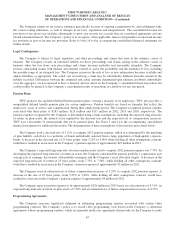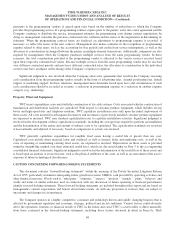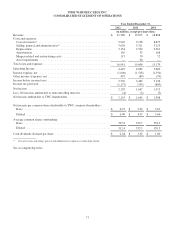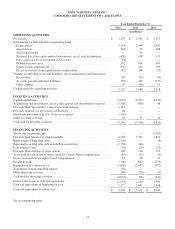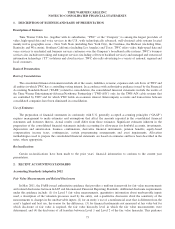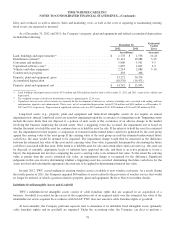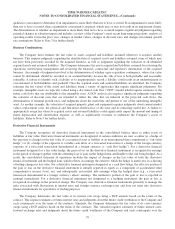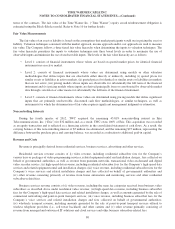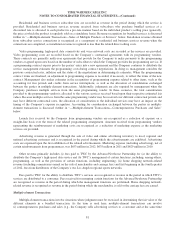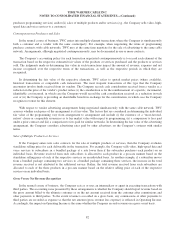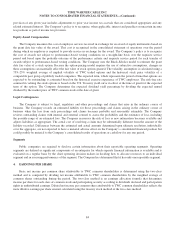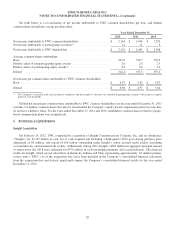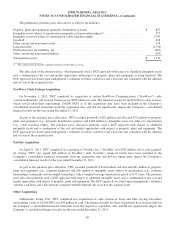Time Warner Cable 2012 Annual Report Download - page 86
Download and view the complete annual report
Please find page 86 of the 2012 Time Warner Cable annual report below. You can navigate through the pages in the report by either clicking on the pages listed below, or by using the keyword search tool below to find specific information within the annual report.TIME WARNER CABLE INC.
NOTES TO CONSOLIDATED FINANCIAL STATEMENTS—(Continued)
became effective for TWC on January 1, 2012 and did not have a material impact on the Company’s consolidated financial
statements.
Testing Goodwill for Impairment
In September 2011, the FASB issued authoritative guidance that allows an entity to use a qualitative approach to test
goodwill for impairment. Under this guidance, an entity has the option to first assess qualitative factors to determine whether
the existence of events or circumstances leads to a determination that it is more likely than not that the fair value of a
reporting unit is less than its carrying amount. If, after assessing the totality of events or circumstances, an entity determines
it is not more likely than not that the fair value of a reporting unit is less than its carrying amount, then performing the two-
step impairment test is unnecessary. In addition, an entity has the option to bypass the qualitative assessment for any
reporting unit in any period and proceed directly to performing the first step of the two-step goodwill impairment test. This
guidance became effective for TWC’s goodwill impairment test performed as of July 1, 2012 and did not have a material
impact on the Company’s consolidated financial statements. Refer to Note 7 for further details regarding the results of the
Company’s annual impairment testing.
Testing Indefinite-Lived Intangible Assets for Impairment
In July 2012, the FASB issued authoritative guidance that allows companies the option to perform a qualitative
assessment to determine whether further impairment testing of indefinite-lived intangible assets is necessary. Under this
guidance, an entity is required to perform a quantitative impairment test if qualitative factors indicate that it is more likely
than not that indefinite-lived intangible assets are impaired. The qualitative factors are similar to the guidance established for
goodwill impairment testing and include identifying and assessing events and circumstances that would most significantly
impact, individually or in the aggregate, the carrying value of the indefinite-lived intangible assets. TWC elected to early
adopt this guidance, which became effective for TWC’s indefinite-lived intangible asset impairment tests performed as of
July 1, 2012 and did not have a material impact on the Company’s consolidated financial statements. Refer to Note 7 for
further details regarding the results of the Company’s annual impairment testing.
Reporting of Amounts Reclassified Out of Accumulated Other Comprehensive Income
In January 2013, the FASB issued authoritative guidance that requires an entity to provide information about the
amounts reclassified out of accumulated other comprehensive income by component. In addition, an entity is required to
present, either on the face of the statement where net income is presented or in the notes, significant amounts reclassified out
of accumulated other comprehensive income by the respective line items of net income but only if the amount reclassified is
required under GAAP to be reclassified to net income in its entirety in the same reporting period. For other amounts that are
not required under GAAP to be reclassified in their entirety to net income (e.g., net periodic pension benefit cost), an entity is
required to cross-reference to other disclosures required under GAAP that provide additional detail about those amounts.
TWC elected to early adopt this guidance during the fourth quarter of 2012, which did not have a material impact on the
Company’s consolidated financial statements.
3. SUMMARY OF SIGNIFICANT ACCOUNTING POLICIES
Cash and Equivalents
Cash and equivalents include money market funds, overnight deposits and other investments that are readily convertible
into cash and have original maturities of three months or less. Cash equivalents are carried at cost, which approximates fair
value.
Short-term Investments in U.S. Treasury Securities
Short-term investments in U.S. Treasury securities have original maturities of six months. Such investments are
classified as held-to-maturity and stated at amortized cost. As of December 31, 2012, held-to-maturity securities have
amortized costs of $150 million, which approximates fair value.
76



